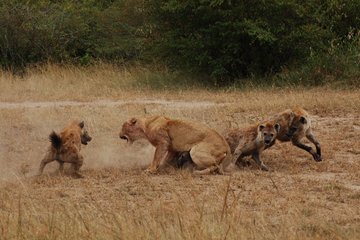Learning from conspecifics
Chimpanzees may use social learning to acquire new skills
Chimpanzees that are unable to figure out a complex puzzle on their own, are capable of learning the solution from other chimps that were trained to solve it. This is the conclusion reached by an international research team from Utrecht University, the University of St Andrews and the Max Planck Institute for Evolutionary Anthropology as part of a study conducted with groups of chimpanzees in Zambia. This study demonstrates, for the first time, that chimpanzees, like humans, can acquire skills from one another that they cannot innovate themselves.

Chimpanzees use sticks to catch termites. Exactly how they use those sticks varies by group. In some groups, for example, the great apes directly put the sticks laden with insects into their mouths. In other groups, the chimps first use their free hand to gather the insects from the stick in a single motion, and then consume the treats from that hand.
It was long assumed that such behavioral differences between groups stemmed from social learning—the ability to learn by observing and imitating conspecifics. Recently, however, some researchers have started to question this notion, casting doubt on the capacity of chimpanzees and other great apes to copy complex actions from one another. Instead, these researchers propose that individual animals are more likely to keep reinventing the wheel, while possibly drawing inspiration from their peers regarding where to go or which attributes to use. The study by van Leeuwen and colleagues now demonstrates that chimpanzees do have the ability to adopt a skill from their conspecifics that they cannot innovate themselves.
Chimpanzees struggle with puzzle box

In the study, van Leeuwen set up a puzzle box containing peanuts in two groups of chimpanzees. Although the animals could see and smell the peanuts, they could not simply reach them. To access the food, the chimpanzees first had to pick up a wooden ball, of which large numbers were scattered throughout the area by the researchers, and bring it to the box. The box had a drawer that the great apes needed to open and keep open (otherwise, it would close due to a tension spring), allowing them to place the ball in a recess within the drawer. Once the ball disappeared into the box through the recess, the chimpanzees received their reward: a handful of peanuts.
In the two groups where the puzzle box was present for three months, none of the animals succeeded in solving the puzzle independently. Van Leeuwen: "They tried everything to reach the peanuts. They attempted to unlock the lid of the box and used the balls to tap and throw at the box. However, none of the animals were able to figure out the solution." When it became evident that the puzzle was too challenging for the chimpanzees, Van Leeuwen and his colleagues initiated training with one reasonably senior and intelligent female from each group. Van Leeuwen: "You cannot just select an animal at random. It has to be one that dares to solve the puzzle within the group and is also allowed to eat the food by the others."
Chimpanzees learn from trained group members
Once these females successfully learned how to obtain the food, the puzzle box was reintroduced to the groups. After two months in the presence of the trained individuals, the researchers observed that 14 out of the total 66 untrained animals were now also capable of solving the puzzle. Each of the animals that ultimately was able to access the peanuts was found to have observed a conspecific successfully obtaining a reward at least nine times. This strongly suggests that these chimpanzees acquired a new and complex skill through social learning.
Social learning is regarded as one of the prerequisites of cumulative cultural evolution, the process by which innovations are transferred from generation to generation and accumulate over time, creating technology that could never have been conceived by a single individual. Cumulative cultural evolution is one of the potential explanations for the complexity and diversity observed in human culture, and is considered by some researchers to be something uniquely human.
Despite the convincing results, the authors believe it is premature to draw broader conclusions based solely on this study. Van Leeuwen: "I think this study is a valuable contribution to our understanding of cultural evolution, but it is only one study. And clear differences still exist between chimpanzees and humans. Humans exhibit a much stronger inclination towards social learning, whereas chimpanzees tend to be more self-focused. For instance, humans readily adopt behaviors from each other that may initially seem to serve no purpose, whereas chimpanzees do not appear to do that in most cases. However, that does not mean they cannot do it. I suspect that the primary factors driving the disparities in cultural expressions between humans and chimpanzees may lie in different domains altogether."













